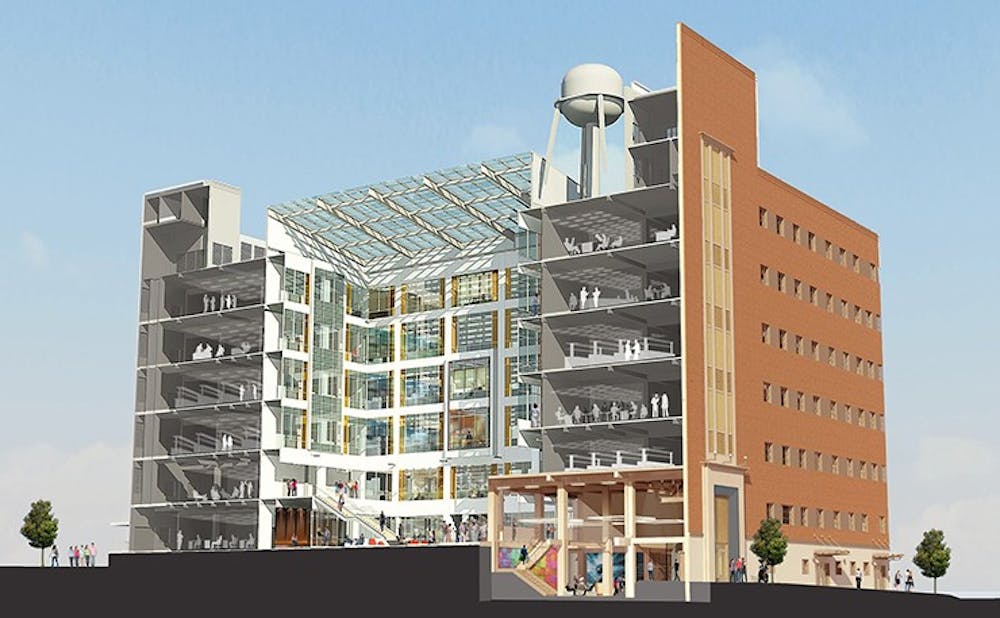A trek to downtown Durham may soon be necessary for some students.
In December 2017, the newly renovated Chesterfield building opened on West Main Street—about a half-mile from East Campus. Duke sponsored the renovation project, and the University now leases about 100,000 square feet of the building for life science lab space. The two courses—BME 464L and certain sections of BME 790L—are holding their lab portions in the building, starting this semester.
The fourth and fifth floors of the Chesterfield are dedicated to the Pratt School of Engineering, including a teaching space for biomedical engineering. Mark Palmeri, associate professor of the practice of biomedical engineering, noted that the building includes a 3,200-square-foot design suite where he holds the lab portions of his design and medical instrumentation courses.
Palmeri is currently the only professor with classes at the new building. His undergraduate and graduate students do not meet in the Chesterfield space for their lab class, but they access the lab whenever needed during the week. He explained that students may go during traditional work hours or evenings, for two to six-plus hours per week, depending on the project.
“The space is a stellar upgrade because it's much larger, so we have a much larger footprint than the other ad-hoc space on campus. It's also equipped with the latest generation equipment to allow students to really not be impeded by any of the instrumentation that they have to use,” Palmeri said.
The building will also house the Bioengineering Research initiative to Develop Global Entrepreneurs program (BRiDGE), which provides accessible lab resources for bioengineering startup companies for Duke students and faculty. 2,000 square-feet of space are dedicated to this program, with six companies currently utilizing the new facility.
The Chesterfield will also be used over the summer for the BME Design Fellows independent study course, where students pursue BME-focused summer internships at companies in Durham. These students will be able to use the new lab space to assist in their work and independent study, which continues through their senior year.
Senior Kevin Mutchnick—a student enrolled in BME 490, certain sections of which are also held in the Chesterfield—said he has had a good experience with the building so far. At first, being downtown seemed like an inconvenience, he said. However, Duke’s free Uber program was extended to include the Chesterfield, which he said was critical to having lab downtown.
Without the free Ubers, “it would be a different story,” Mutchnick said.
He said he understands the Chesterfield commute can be inconvenient for students—especially if they schedule their trips right before or after other classes. However, he noted that his professor and the hours he works at the lab are flexible. Mutchnick said being off campus during the day is also a nice change of pace, and the facility is nice because it is brand new.
Moving into the building was strategically beneficial since it will help the BME department grow their curricular offerings, Palmeri explained. Previously, there was a one-semester senior design class. Now, there is a first-year semester-long design class and a year-long senior design experience. Additionally, he stated that the design and instrumentation courses have been popular among graduate students.
“As we grow into both expanded senior capstone design courses and augmented graduate-level design offerings, there definitely was a need to have more lab capacity to accommodate all those offerings,” Palmeri said.
He said he is also excited to work with the growing medical device community in Durham and having a teaching lab close to these companies. The downtown space allows the students to have greater exposure to job and learning opportunities that were not as accessible in the on-campus labs.
With outside companies leasing space in the Chesterfield, the new space is “injecting additional opportunities” for students, Palmeri noted. It allows students to find internships and have interactions with BME companies year-round.
“There are actual biotech companies in the building that are also there with the Duke labs, and it's a cool insight into what the biotech industry is like,” Mutchnick said. “I wasn't expecting that.”
Correction: This article was updated to reflect that Mutchnick's BME 490 class was in the Chesterfield building, since he is not in BME 464. The Chronicle regrets the error.
Get The Chronicle straight to your inbox
Signup for our weekly newsletter. Cancel at any time.

